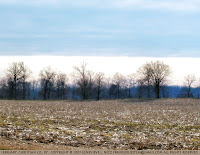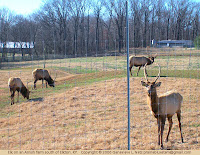Life in Christian County, Kentucky... The Rural Life...
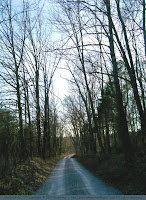 Isaac and I had a nice walk late this afternoon, down a narrow and somewhat winding road near our home. It's about .8 mile from the beginning of the road to the point that it changes from gravel to blacktop. The round trip is 1.6 miles with a couple big hills to increase the heart rate.
Isaac and I had a nice walk late this afternoon, down a narrow and somewhat winding road near our home. It's about .8 mile from the beginning of the road to the point that it changes from gravel to blacktop. The round trip is 1.6 miles with a couple big hills to increase the heart rate.The road is so narrow that two vehicles cannot meet on it. When that rare event does occur, one has to either back up or wait in a pasture gateway along the road until the other vehicle passes.
We didn't meet any vehicles at all while we were walking. It was very quiet and pleasant, walking along through the trees and beside the pastures and fields.
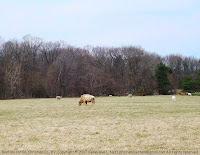 Our neighbor has his Beefalo cattle in some of the pastures along the way. The buffalo ancestry of his bull is quite obvious.
Our neighbor has his Beefalo cattle in some of the pastures along the way. The buffalo ancestry of his bull is quite obvious.The fields haven't been touched yet, but I'm sure the farmers are preparing their machinery and ordering the seed.
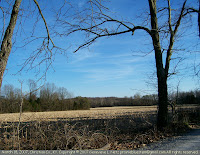 Coming back up the last hill, we heard a bird calling close beside the road. Isaac spotted him in a thicket when he moved. It was an eastern towhee (also called a rufous-sided towhee.) I have seen them in our yard infrequently, but often enough that I recognize them.
Coming back up the last hill, we heard a bird calling close beside the road. Isaac spotted him in a thicket when he moved. It was an eastern towhee (also called a rufous-sided towhee.) I have seen them in our yard infrequently, but often enough that I recognize them.After listening to some recordings of the towhee's calls on the internet this evening, I realize that he was making the "towhee" sound that the bird is named for. You can read more about the eastern towhee and hear its call on the Cornell Lab of Ornithology website (Real Player needed) or on the Wild Bird Watching website (mp3 player needed).
The weather here has been so nice lately for walking -- cool, but not cold. This is the second time that Isaac and I have walked down this road this week. We can walk up and down the hill from our house to the highway three times and have about the same distance, but a change of scenery always makes walking more interesting.
Eastern towhee, National Park Service photo

Technorati tags:


